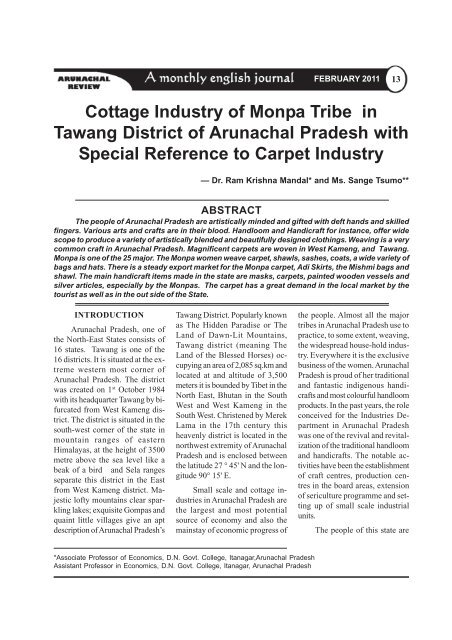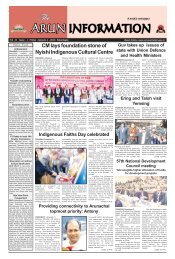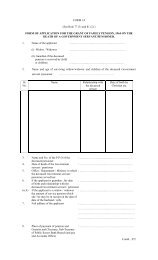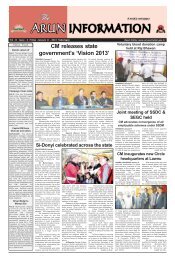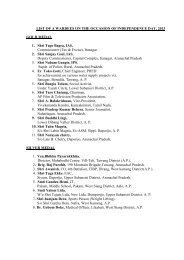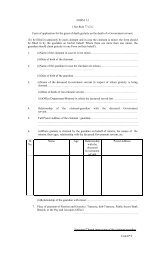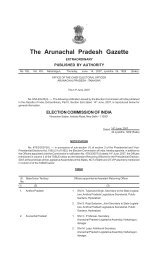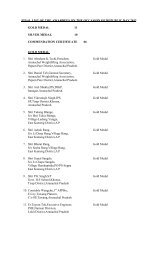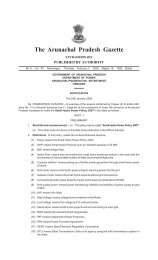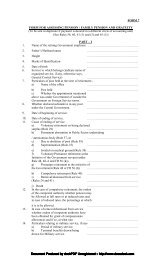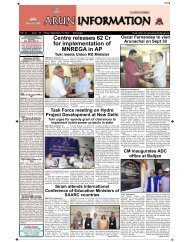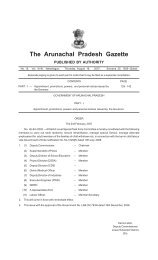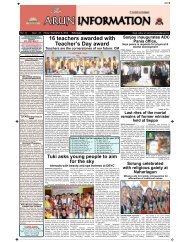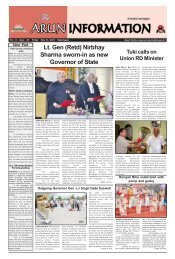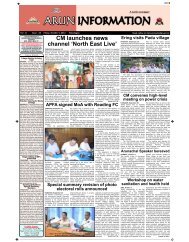Cottage Industry of Monpa Tribe in Tawang District of Arunachal ...
Cottage Industry of Monpa Tribe in Tawang District of Arunachal ...
Cottage Industry of Monpa Tribe in Tawang District of Arunachal ...
You also want an ePaper? Increase the reach of your titles
YUMPU automatically turns print PDFs into web optimized ePapers that Google loves.
INTRODUCTION<br />
<strong>Arunachal</strong> Pradesh, one <strong>of</strong><br />
the North-East States consists <strong>of</strong><br />
16 states. <strong>Tawang</strong> is one <strong>of</strong> the<br />
16 districts. It is situated at the extreme<br />
western most corner <strong>of</strong><br />
<strong>Arunachal</strong> Pradesh. The district<br />
was created on 1st October 1984<br />
with its headquarter <strong>Tawang</strong> by bifurcated<br />
from West Kameng district.<br />
The district is situated <strong>in</strong> the<br />
south-west corner <strong>of</strong> the state <strong>in</strong><br />
mounta<strong>in</strong> ranges <strong>of</strong> eastern<br />
Himalayas, at the height <strong>of</strong> 3500<br />
metre above the sea level like a<br />
beak <strong>of</strong> a bird and Sela ranges<br />
separate this district <strong>in</strong> the East<br />
from West Kameng district. Majestic<br />
l<strong>of</strong>ty mounta<strong>in</strong>s clear sparkl<strong>in</strong>g<br />
lakes; exquisite Gompas and<br />
qua<strong>in</strong>t little villages give an apt<br />
description <strong>of</strong> <strong>Arunachal</strong> Pradesh’s<br />
FEBRUARY 2011<br />
<strong>Cottage</strong> <strong>Industry</strong> <strong>of</strong> <strong>Monpa</strong> <strong>Tribe</strong> <strong>in</strong><br />
<strong>Tawang</strong> <strong>District</strong> <strong>of</strong> <strong>Arunachal</strong> Pradesh with<br />
Special Reference to Carpet <strong>Industry</strong><br />
— Dr. Ram Krishna Mandal* and Ms. Sange Tsumo**<br />
ABSTRACT<br />
The people <strong>of</strong> <strong>Arunachal</strong> Pradesh are artistically m<strong>in</strong>ded and gifted with deft hands and skilled<br />
f<strong>in</strong>gers. Various arts and crafts are <strong>in</strong> their blood. Handloom and Handicraft for <strong>in</strong>stance, <strong>of</strong>fer wide<br />
scope to produce a variety <strong>of</strong> artistically blended and beautifully designed cloth<strong>in</strong>gs. Weav<strong>in</strong>g is a very<br />
common craft <strong>in</strong> <strong>Arunachal</strong> Pradesh. Magnificent carpets are woven <strong>in</strong> West Kameng, and <strong>Tawang</strong>.<br />
<strong>Monpa</strong> is one <strong>of</strong> the 25 major. The <strong>Monpa</strong> women weave carpet, shawls, sashes, coats, a wide variety <strong>of</strong><br />
bags and hats. There is a steady export market for the <strong>Monpa</strong> carpet, Adi Skirts, the Mishmi bags and<br />
shawl. The ma<strong>in</strong> handicraft items made <strong>in</strong> the state are masks, carpets, pa<strong>in</strong>ted wooden vessels and<br />
silver articles, especially by the <strong>Monpa</strong>s. The carpet has a great demand <strong>in</strong> the local market by the<br />
tourist as well as <strong>in</strong> the out side <strong>of</strong> the State.<br />
<strong>Tawang</strong> <strong>District</strong>. Popularly known<br />
as The Hidden Paradise or The<br />
Land <strong>of</strong> Dawn-Lit Mounta<strong>in</strong>s,<br />
<strong>Tawang</strong> district (mean<strong>in</strong>g The<br />
Land <strong>of</strong> the Blessed Horses) occupy<strong>in</strong>g<br />
an area <strong>of</strong> 2,085 sq.km and<br />
located at and altitude <strong>of</strong> 3,500<br />
meters it is bounded by Tibet <strong>in</strong> the<br />
North East, Bhutan <strong>in</strong> the South<br />
West and West Kameng <strong>in</strong> the<br />
South West. Christened by Merek<br />
Lama <strong>in</strong> the 17th century this<br />
heavenly district is located <strong>in</strong> the<br />
northwest extremity <strong>of</strong> <strong>Arunachal</strong><br />
Pradesh and is enclosed between<br />
the latitude 27 ° 45' N and the longitude<br />
90° 15' E.<br />
Small scale and cottage <strong>in</strong>dustries<br />
<strong>in</strong> <strong>Arunachal</strong> Pradesh are<br />
the largest and most potential<br />
source <strong>of</strong> economy and also the<br />
ma<strong>in</strong>stay <strong>of</strong> economic progress <strong>of</strong><br />
*Associate Pr<strong>of</strong>essor <strong>of</strong> Economics, D.N. Govt. College, Itanagar,<strong>Arunachal</strong> Pradesh<br />
Assistant Pr<strong>of</strong>essor <strong>in</strong> Economics, D.N. Govt. College, Itanagar, <strong>Arunachal</strong> Pradesh<br />
13<br />
the people. Almost all the major<br />
tribes <strong>in</strong> <strong>Arunachal</strong> Pradesh use to<br />
practice, to some extent, weav<strong>in</strong>g,<br />
the widespread house-hold <strong>in</strong>dustry.<br />
Everywhere it is the exclusive<br />
bus<strong>in</strong>ess <strong>of</strong> the women. <strong>Arunachal</strong><br />
Pradesh is proud <strong>of</strong> her traditional<br />
and fantastic <strong>in</strong>digenous handicrafts<br />
and most colourful handloom<br />
products. In the past years, the role<br />
conceived for the Industries Department<br />
<strong>in</strong> <strong>Arunachal</strong> Pradesh<br />
was one <strong>of</strong> the revival and revitalization<br />
<strong>of</strong> the traditional handloom<br />
and handicrafts. The notable activities<br />
have been the establishment<br />
<strong>of</strong> craft centres, production centres<br />
<strong>in</strong> the board areas, extension<br />
<strong>of</strong> sericulture programme and sett<strong>in</strong>g<br />
up <strong>of</strong> small scale <strong>in</strong>dustrial<br />
units.<br />
The people <strong>of</strong> this state are
14<br />
FEBRUARY 2011<br />
artistically m<strong>in</strong>ded and gifted with<br />
deft hands and skilled f<strong>in</strong>gers.<br />
Various arts and crafts are <strong>in</strong> their<br />
blood. Handloom and Handicraft<br />
for <strong>in</strong>stance, <strong>of</strong>fer wide scope to<br />
produce a variety <strong>of</strong> artistically<br />
blended and beautifully designed<br />
cloth<strong>in</strong>gs. Weav<strong>in</strong>g is a very common<br />
craft <strong>in</strong> <strong>Arunachal</strong> Pradesh.<br />
Magnificent carpets are woven <strong>in</strong><br />
West Kameng, <strong>Tawang</strong> and <strong>in</strong><br />
northern Siang; while beautiful rugs<br />
are woven <strong>in</strong> the Adi area. The<br />
Adis are excellent <strong>in</strong> the production<br />
<strong>of</strong> useful eye-catch<strong>in</strong>g handicrafts<br />
products and textile bear<br />
ample testimony to the rich heritage.<br />
Their nimble f<strong>in</strong>gers weave<br />
excellent designs on the textiles<br />
and carpets. They also cultivate<br />
cotton <strong>in</strong> their jhum fields<br />
alongwith other produces. Vivid<br />
colours and exquisite patterns,<br />
sometime abstract and at other floral;<br />
are the hallmark <strong>of</strong> the weav<strong>in</strong>g<br />
wool, cotton and silk throughout<br />
the territory. The Nyishi<br />
women weave <strong>in</strong> both cotton as<br />
well as Pudu Plant fibre to produce<br />
blankets, skirts, lion cloths and<br />
waist bands. They grow a large<br />
amount <strong>of</strong> cotton especially <strong>in</strong> the<br />
valleys <strong>of</strong> Panior and Pal<strong>in</strong>. They<br />
use natural dyes which are extracted<br />
from jungle creepers and<br />
certa<strong>in</strong> plants such as black from<br />
Kukhi, red from Tam<strong>in</strong> creeper<br />
and green from Ungu plant to<br />
colour their yarn used for borders.<br />
The Apa Tani women also work<br />
<strong>in</strong> wool to weave ceremonial<br />
shawls, coats and to embroider<br />
cotton cloth. They usually extract<br />
red dye from manjeet and black<br />
from Yango Leaves. The Mishmis<br />
women have a great reputation <strong>in</strong><br />
weav<strong>in</strong>g. They grow cotton on a<br />
small scale <strong>in</strong> the neighbourhood<br />
<strong>of</strong> Ro<strong>in</strong>g. They weave <strong>in</strong> cotton,<br />
wool plant fibres <strong>of</strong> different k<strong>in</strong>ds<br />
especially Rhea Nivea to produce<br />
varieties <strong>of</strong> clothes that <strong>in</strong>clude lion<br />
and waist cloths, aprons, sleeveless<br />
coats, jackets, skirts, scarves,<br />
embroidered bodies, shawls,<br />
sashes, bands, belts and bags. The<br />
Khamptis and S<strong>in</strong>gpho women produce<br />
almost all the necessary<br />
clothes both for themselves and<br />
their men. The Tangsa women<br />
ma<strong>in</strong>ly produce hand-bags, skirts<br />
and lungis <strong>of</strong> different patterns.<br />
Both the S<strong>in</strong>gpho and Tangsa<br />
women are experts <strong>in</strong> mak<strong>in</strong>g ceremonial<br />
costumes, which show<br />
their artistry and skill <strong>in</strong> weav<strong>in</strong>g.<br />
They all produce cotton on a smallscale.<br />
Different items made <strong>of</strong> cane<br />
and bamboo are found among the<br />
Apa Tanis, Hill Miris and Adis. The<br />
famous wood carv<strong>in</strong>g articles<br />
found among the Noctes and<br />
Wanchos. In short, we f<strong>in</strong>d among<br />
the tribal people a wide variety <strong>of</strong><br />
crafts that <strong>in</strong>clude weav<strong>in</strong>g, pa<strong>in</strong>t<strong>in</strong>g,<br />
pottery, smithy work, bamboo<br />
and cane work, wood carv<strong>in</strong>g and<br />
basketry. Tribal handloom <strong>of</strong><br />
<strong>Arunachal</strong> Pradesh are well<br />
known and greatly priced not only<br />
<strong>in</strong> the territory but outside the<br />
country also. The old art are los<strong>in</strong>g<br />
<strong>in</strong> utility as the pattern <strong>of</strong> life<br />
changes. Now due to modernization,<br />
the traditional dress and arts<br />
and crafts are replaced by the new<br />
one. It is the <strong>Industry</strong> Department<br />
which has to look after to save the<br />
traditional arts and crafts from<br />
ext<strong>in</strong>ction, otherwise ultimately it<br />
will be vanished. Thus different<br />
tribes have their different designs<br />
<strong>in</strong> their hand loom and handicraft<br />
products.<br />
The <strong>Monpa</strong> women weave<br />
carpet, shawls, sashes, coats, a<br />
wide variety <strong>of</strong> bags and hats.<br />
There is a steady export market<br />
for the <strong>Monpa</strong> carpet, Adi Skirts,<br />
the Mishmi bags and shawl. The<br />
ma<strong>in</strong> handicraft items made <strong>in</strong><br />
the state are masks, carpets,<br />
pa<strong>in</strong>ted wooden vessels and<br />
silver articles, especially by the<br />
<strong>Monpa</strong>s. Here the author centralized<br />
her m<strong>in</strong>d only <strong>in</strong> context <strong>of</strong><br />
carpet <strong>in</strong>dustry <strong>of</strong> the <strong>Monpa</strong><br />
tribe.This paper is divided <strong>in</strong>to four<br />
sections. The first section deals<br />
with <strong>in</strong>troduction focus<strong>in</strong>g on the<br />
different style <strong>of</strong> handloom and<br />
handicraft product <strong>of</strong> different<br />
tribes. The second section high<br />
lights the scope and objectives,<br />
geographical area under study, and<br />
methodology and data source <strong>of</strong><br />
the study. The third section exam<strong>in</strong>es<br />
the socio-economic pr<strong>of</strong>ile<br />
<strong>of</strong> <strong>Monpa</strong> tribe while the fourth i.e.,<br />
the last section searches prospect<br />
<strong>of</strong> carpet <strong>in</strong>dustry <strong>in</strong> socio-economic<br />
development <strong>of</strong> <strong>Monpa</strong><br />
<strong>Tribe</strong> and conclusion follows.<br />
SECTION-II<br />
Scope and Objectives <strong>of</strong> the<br />
Paper<br />
In spite <strong>of</strong> its vast natural resources,<br />
<strong>Arunachal</strong> Pradesh is <strong>in</strong>dustrially<br />
backward. A number <strong>of</strong><br />
reasons are cited for slow growth<br />
<strong>of</strong> <strong>in</strong>dustries <strong>in</strong> the State as well<br />
as <strong>in</strong> the North-Eastern Region as<br />
a whole. While, some <strong>of</strong> these reasons<br />
are geographical, some others<br />
are <strong>in</strong>frastructural and the rest<br />
are purely political <strong>in</strong> character.
The reasons like geographical isolation,<br />
<strong>in</strong>frastructural bottlenecks,<br />
scarcity <strong>of</strong> capital, smaller size <strong>of</strong><br />
market, lack <strong>of</strong> skilled labour, etc<br />
might be responsible for slow<br />
growth <strong>of</strong> big or large scale <strong>in</strong>dustries<br />
<strong>in</strong> the state (as well as for the<br />
NER as a whole) to a large extent.<br />
But, the same set <strong>of</strong> factors<br />
can not be held accountable for the<br />
slow growth <strong>of</strong> small scale and<br />
cottage <strong>in</strong>dustries based on its traditional<br />
handicrafts like carpet <strong>in</strong>dustry<br />
<strong>of</strong> the district <strong>in</strong> particular<br />
and <strong>in</strong> the State <strong>in</strong> general. The<br />
region is blessed with natural<br />
abundance <strong>of</strong> Cane and Bamboo<br />
the basic raw materials used for<br />
the handicrafts <strong>in</strong>dustry and at the<br />
same time the highly skilled manpower<br />
for these crafts are also<br />
available <strong>in</strong> the region. Therefore,<br />
there is ample scope <strong>of</strong> development<br />
<strong>of</strong> the traditional crafts like<br />
cane and bamboo crafts and carpet<br />
<strong>in</strong>dustry <strong>of</strong> the region. These<br />
crafts could be an eng<strong>in</strong>e for economic<br />
growth <strong>of</strong> the region, if adequate<br />
measures are taken at different<br />
levels to boost up these<br />
crafts.<br />
With a view to highlight the<br />
above fact, the study has been<br />
carried out with the follow<strong>in</strong>g objectives:<br />
1. To discuss socio-economic<br />
pr<strong>of</strong>ile <strong>of</strong> <strong>Monpa</strong> tribe.<br />
2. To explore the prospect <strong>of</strong><br />
carpet <strong>in</strong>dustry <strong>in</strong> socio-economic<br />
development <strong>of</strong><br />
<strong>Monpa</strong> <strong>Tribe</strong> <strong>in</strong> the district <strong>in</strong><br />
particular and <strong>in</strong> the state <strong>in</strong><br />
general.<br />
Geographical Area under<br />
Study: The Geographical area<br />
under study has covered <strong>Tawang</strong><br />
Town and its surround<strong>in</strong>g area concentrat<strong>in</strong>g<br />
the m<strong>in</strong>d only <strong>in</strong> <strong>Monpa</strong><br />
women.<br />
Methodology and Data<br />
Source: Data are collected ma<strong>in</strong>ly<br />
from primary sources with the help<br />
<strong>of</strong> pre-structured questionnaires<br />
on the basis <strong>of</strong> random sampl<strong>in</strong>g.<br />
Secondary data is also used where<br />
it is felt necessary. The <strong>in</strong>terview<br />
was taken <strong>in</strong> the month <strong>of</strong> June,<br />
2009 from only women respondents<br />
<strong>of</strong> age group 40 or more<br />
than 40 years. Because, the author<br />
thought that this group would<br />
be more stabilized <strong>in</strong> their pr<strong>of</strong>ession<br />
and could say whether they<br />
would keep this crafts for their<br />
future generation or not. The number<br />
<strong>of</strong> respondents was 20. The<br />
<strong>in</strong>dicators are only <strong>in</strong>dicative and<br />
highly subjective at this moment,<br />
and are not exhaustive enough.<br />
There is need for further sharpen<strong>in</strong>g<br />
them <strong>in</strong> terms <strong>of</strong> <strong>in</strong>dicators.<br />
However, these answers/ op<strong>in</strong>ions<br />
were sought at the entrepreneurial<br />
level, probably from the owner<br />
<strong>of</strong> the enterprise. For the study<br />
samples were selected through<br />
random sample technique from the<br />
enterprises spread over the length<br />
and breadth <strong>of</strong> the district.<br />
SECTION-III<br />
Socio-Economic Pr<strong>of</strong>ile <strong>of</strong><br />
<strong>Monpa</strong> <strong>Tribe</strong><br />
The <strong>Monpa</strong>s are <strong>in</strong>habitant <strong>of</strong><br />
the West Kameng and <strong>Tawang</strong> districts<br />
<strong>of</strong> <strong>Arunachal</strong> Pradesh. They<br />
are Buddhist by religion and pr<strong>of</strong>ess<br />
Mahayana / Lama strict sect.<br />
Their society is patrilocal and<br />
patril<strong>in</strong>eal. The number <strong>of</strong> nuclear<br />
family is common and monogamy<br />
FEBRUARY 2011<br />
15<br />
is the usual form <strong>of</strong> marriage.<br />
Their primary economy is based<br />
on agriculture, rear<strong>in</strong>g livestock<br />
and trade. The society is governed<br />
by a council called Mongiombare<br />
headed by Tsorgen, but the role <strong>of</strong><br />
the Buddhist priest (Lama) is significant<br />
<strong>in</strong> every sphere <strong>of</strong> their<br />
socio-cultural life.<br />
Accord<strong>in</strong>g to 2001census,<br />
there were an approximate number<br />
<strong>of</strong> 25 major tribes and 110<br />
tribes and sub-tribes <strong>in</strong>habited the<br />
entire State. <strong>Monpa</strong> is one <strong>of</strong> the<br />
major tribes <strong>of</strong> the State. The pr<strong>in</strong>cipal<br />
<strong>in</strong>habitants <strong>of</strong> the State <strong>of</strong><br />
<strong>Arunachal</strong> Pradesh from east to<br />
west are the tribes <strong>of</strong> Wancho,<br />
Nocte, Tangsa, S<strong>in</strong>gpho, Khamti,<br />
Mishmi, Adi, Galo, Padam,<br />
M<strong>in</strong>yong, Pailibo, Bokar, Bori,<br />
Memba, Khamba, Apatani, Nyishi,<br />
Hill Miri, Nah, Tag<strong>in</strong>, Aka, Khowa<br />
or Bugun, Miji, Sulung, Sherdukpen<br />
and <strong>Monpa</strong>. They exhibit a dist<strong>in</strong>ctive<br />
culture, customs and traditions.<br />
These tribes are scattered over an<br />
area <strong>of</strong> 83,743 Sq. km. <strong>in</strong> hilly terra<strong>in</strong><br />
<strong>of</strong> Eastern Himalayas. The<br />
concentration <strong>of</strong> tribal population<br />
throughout the border region<br />
though very high is scattered <strong>in</strong><br />
small villages with un<strong>in</strong>habited<br />
habitations <strong>in</strong> higher altitudes.<br />
The <strong>Monpa</strong>s are found <strong>in</strong> the<br />
highland regions <strong>of</strong> the West<br />
Kameng and the <strong>Tawang</strong> districts<br />
<strong>of</strong> the State. Their number was<br />
38,862 as per 1991 census, and<br />
43344 as per 2001 census. Their<br />
ma<strong>in</strong> centres <strong>of</strong> habitation are <strong>in</strong><br />
and around the adm<strong>in</strong>istrative<br />
headquarters <strong>of</strong> <strong>Tawang</strong>, Dirang<br />
and Kalaktang. Bas<strong>in</strong>g on the place<br />
<strong>of</strong> liv<strong>in</strong>g and the geographical location<br />
<strong>of</strong> these centres, they are
16<br />
FEBRUARY 2011<br />
<strong>of</strong>ten called as <strong>Tawang</strong> or Northern,<br />
Dirang or central and<br />
Kalaktang or Southern Monaps. In<br />
Tibetan dialect, the name Mon and<br />
pa signify the men <strong>of</strong> the lower<br />
country.<br />
The <strong>in</strong>habitants <strong>of</strong> the<br />
<strong>Tawang</strong> district are the <strong>Monpa</strong>s<br />
belong<strong>in</strong>g to the Mahayana Sect<br />
<strong>of</strong> Buddhism. The <strong>Monpa</strong>s are divided<br />
<strong>in</strong>to three groups, viz. Dirang<br />
or Central. <strong>Tawang</strong> or Northern<br />
and Kalakatang or Southern, that<br />
are named after the geographical<br />
locations <strong>of</strong> their concentration.<br />
The <strong>Monpa</strong>s are extremely self reliant;<br />
they constructed their own<br />
<strong>in</strong>ter village path, build their own<br />
cane bridge, devised their own <strong>in</strong>digenous<br />
equipments to husk or<br />
gr<strong>in</strong>d rice and millets, weav<strong>in</strong>g<br />
their own cloths, ornaments & jewels,<br />
hats, cook<strong>in</strong>g vessels, weapons.<br />
This shows the exceptional<br />
similarities <strong>of</strong> Gandhian concept <strong>of</strong><br />
self-reliance <strong>in</strong> the tribal Communities<br />
<strong>of</strong> the state.<br />
However, there was hardly<br />
any development. The economy<br />
and the society at the dawn <strong>of</strong> <strong>in</strong>dependence<br />
were primitive. But,<br />
now the days are fast mov<strong>in</strong>g far<br />
from culture <strong>of</strong> self-sufficiency <strong>in</strong><br />
this tribal soil. This district is proud<br />
<strong>of</strong> her traditional and fantastic <strong>in</strong>digenous<br />
handicrafts and most<br />
colourful handloom products. They<br />
are excellent <strong>in</strong> the production <strong>of</strong><br />
useful eye-catch<strong>in</strong>g handicrafts.<br />
Their handicrafts products and textile<br />
bear ample testimony to the<br />
rich heritage. Their nimble f<strong>in</strong>gers<br />
weave excellent designs on the<br />
textiles and carpets. The <strong>in</strong>tricately<br />
executed woodcrafts, cane and<br />
bamboo works, black smithy,<br />
leather work<strong>in</strong>g, pottery mak<strong>in</strong>g,<br />
paper mak<strong>in</strong>g and weav<strong>in</strong>g bear<br />
eloquent testimony to the f<strong>in</strong>e artistic<br />
temperament and poetic<br />
imag<strong>in</strong>ation <strong>of</strong> the hardwork<strong>in</strong>g<br />
tribesmen <strong>of</strong> these area.<br />
The mounta<strong>in</strong>ous terra<strong>in</strong> <strong>of</strong><br />
<strong>Tawang</strong> comprises <strong>of</strong> the snow<br />
capped Higher Himalayan ranges<br />
and sparsely populated plateaus<br />
and valleys, which are dra<strong>in</strong>ed by<br />
the <strong>Tawang</strong>chu and Nyamyanchu<br />
rivers. Subject to low temparture<br />
throughout the year the higher Alp<strong>in</strong>e<br />
tracts <strong>of</strong> <strong>Tawang</strong> also experience<br />
heavy snowfall. The name<br />
<strong>Tawang</strong> was given by Merek<br />
Lama <strong>in</strong> the 17th century. <strong>Tawang</strong><br />
Monastery popularly known as the<br />
‘<strong>Tawang</strong> Gonpa’ is the second oldest<br />
Monastery <strong>in</strong> Asia more than<br />
460 years old and the largest Monastery<br />
<strong>in</strong> the Himalayan region<br />
constructed by Lama Lodre<br />
Gyatso <strong>in</strong> 1681 A.D. <strong>Tawang</strong> is the<br />
birth place <strong>of</strong> the sixth Dalai Lama,<br />
the only Indian so far who rose to<br />
the highest position <strong>in</strong> Gelupa sect<br />
<strong>of</strong> Buddhism. The <strong>in</strong>habitants <strong>of</strong><br />
this district are the <strong>Monpa</strong>s. They<br />
are Buddhists by faith. They follow<br />
the Gelupa sect <strong>of</strong> Mahayana<br />
stream <strong>of</strong> Buddhism preached by<br />
the <strong>Tawang</strong> Monastery, the founta<strong>in</strong>head<br />
<strong>of</strong> faith and religion. This<br />
district is full <strong>of</strong> Monasteries both<br />
big and small. All efforts have been<br />
made to make this image accurate.<br />
However Compare InfoBase Limited<br />
and its directors do not own<br />
any responsibility for the correctness<br />
or authenticity <strong>of</strong> the same.<br />
There are 3 sub-divisions namely<br />
<strong>Tawang</strong>, Jang and Lumla with 3<br />
blocks as <strong>Tawang</strong>, Mukto-Thimbu<br />
and Lumla hav<strong>in</strong>g 9 numbers <strong>of</strong><br />
adm<strong>in</strong>istrative circles as <strong>Tawang</strong>,<br />
Kitpi, Bongkhar, Th<strong>in</strong>gbu, Mukto,<br />
Jang, Lumla, Zemithang and<br />
Dudunghar.<br />
The economy is primarily<br />
agrarian with people rais<strong>in</strong>g potato;<br />
maize, millets, and etc. the people<br />
also rear yaks, sheep, pony, cows<br />
and goats. Tourism too is an upcom<strong>in</strong>g<br />
revenue-generat<strong>in</strong>g sector<br />
<strong>in</strong> the district. Besides handicrafts<br />
are the forte <strong>of</strong> the local women<br />
folk who practice weav<strong>in</strong>g and<br />
make <strong>in</strong>cense sticks. The charm<strong>in</strong>g<br />
<strong>Tawang</strong> <strong>District</strong> mesmerizes<br />
tourists and br<strong>in</strong>gs home to them<br />
the fact that heaven is a place on<br />
earth. This paradise <strong>of</strong>fers a platter<br />
full <strong>of</strong> traditional monasteries<br />
and nunneries that sightseers can<br />
visit, the most famous be<strong>in</strong>g the<br />
prist<strong>in</strong>e <strong>Tawang</strong> Monastery or<br />
Golden Namgyal Lhatse. Besides<br />
the Sangestser and Pankang Teng<br />
Tso lakes, the Sela and Geshila<br />
Mounta<strong>in</strong> pass, the Tsh<strong>in</strong>bu and<br />
Tsachu hot spr<strong>in</strong>gs are testimonial<br />
to the scenic beauty <strong>of</strong> <strong>Tawang</strong>.<br />
The Jaswant Garh, <strong>Tawang</strong> War<br />
Memorial, Manujshree Vidyapith<br />
and Crafts Center are also worth<br />
visit<strong>in</strong>g. The monasteries primarily<br />
<strong>of</strong>fer academic facilities <strong>in</strong> <strong>Tawang</strong><br />
<strong>District</strong>. The orpahanages also<br />
have their own schools. The Buddha<br />
Culture and Education Foundation<br />
School, Lumla (<strong>Tawang</strong>) is<br />
reputed <strong>in</strong>stitute provid<strong>in</strong>g quality<br />
education <strong>in</strong> the district. <strong>Tawang</strong>,<br />
opulent <strong>in</strong> its cultural heritage and<br />
m<strong>in</strong>d-blow<strong>in</strong>g natural beauty is a<br />
bag full <strong>of</strong> treasure for those whose<br />
wanderlust takes them to this unexplored<br />
terra<strong>in</strong>.<br />
The district is <strong>in</strong>habited by<br />
181 numbers <strong>of</strong> villages with 8294
households. The total population <strong>of</strong><br />
the area is 38924 from which<br />
21846 are male and 17078 are female.<br />
The sex ratio is 782. The<br />
density <strong>of</strong> population is 18 per sq.<br />
km. as per 2001 census. The distance<br />
from district headquarter to<br />
state capital is 580 km. The total<br />
length <strong>of</strong> roads under APPWD is<br />
140.759 kms., under forest is 0.650<br />
kms. And under RWD is 114.20<br />
kms. There is 5 numbers <strong>of</strong> suspension<br />
bridges. In the case <strong>of</strong> telecommunication<br />
there is one telephone<br />
<strong>of</strong>fice, 6 telephone exchange,<br />
2466 telephone connections<br />
with 491 number <strong>of</strong> STD facilities<br />
and has 80 PCOs with the<br />
telephone exchange capacity <strong>of</strong><br />
4228 number. The total number <strong>of</strong><br />
banks are 5 out <strong>of</strong> that 3 are the<br />
branches <strong>of</strong> SBI and 2 are the<br />
branches <strong>of</strong> A.P. co-operative<br />
Apex Bank. There is 4 Micro<br />
Hydel Project with the capacity <strong>of</strong><br />
160.00 kw. And there is solar photovoltaic<br />
programme which electrified<br />
1 village. The district has<br />
47.3% <strong>of</strong> literacy rate for the education<br />
purpose there is 77 govt.<br />
<strong>in</strong>stitutions (schools) and 11 Private<br />
<strong>in</strong>stitutions (schools). As govt.<br />
<strong>in</strong>stitutions there is 2 higher secondary,<br />
3 secondary, 20 middle and<br />
52 primary schools and as private<br />
<strong>in</strong>stitution 2 higher secondary, 1<br />
secondary, 3 middle and 5 primary<br />
schools are there. This district has<br />
23 numbers <strong>of</strong> permanently registered<br />
village and SSI units and provid<strong>in</strong>g<br />
110 number <strong>of</strong> employment<br />
with the <strong>in</strong>vestment <strong>of</strong> Rs 25.20<br />
lakhs. There is 1 <strong>in</strong>dustrial estate<br />
areas <strong>of</strong> 7.08 acre. In addition to<br />
that, there is 2 craft/weav<strong>in</strong>g centres<br />
with 40 tra<strong>in</strong>ees.<br />
SECTION-IV<br />
Prospect <strong>of</strong> Carpet <strong>Industry</strong><br />
<strong>in</strong> Socio-Economic Development<br />
<strong>of</strong> <strong>Monpa</strong> <strong>Tribe</strong> <strong>in</strong> the<br />
<strong>District</strong> <strong>in</strong> Particular and <strong>in</strong><br />
the State <strong>in</strong> General<br />
The <strong>Monpa</strong>s are <strong>in</strong>dustrious<br />
and famous for their arts and crafts<br />
which are unique <strong>in</strong> nature. The<br />
man-folk are expert craftsman <strong>in</strong><br />
pa<strong>in</strong>t<strong>in</strong>g, wood carv<strong>in</strong>g and mask<br />
mak<strong>in</strong>g; while the women are good<br />
<strong>in</strong> their loom and produce wide<br />
range <strong>of</strong> carpets besides their traditional<br />
dresses. A substantial<br />
amount <strong>of</strong> cash has been earned<br />
by the commercial production <strong>of</strong><br />
these items and thereby enable to<br />
them to strengthen their traditional<br />
economy.The carpet mak<strong>in</strong>g is one<br />
<strong>of</strong> the economically viable craft <strong>of</strong><br />
the <strong>Monpa</strong>s. Each and every family<br />
usually process at least one carpet<br />
<strong>in</strong> their house. The women <strong>in</strong><br />
particular are proud <strong>of</strong> the carpet<br />
they weave. Though they are busy<br />
<strong>in</strong> the house-hold task from morn<strong>in</strong>g<br />
to even<strong>in</strong>g even then they f<strong>in</strong>d<br />
out sometime to weave carpet for<br />
their own use. Those who can<br />
spare time have considered this<br />
craft as a secondary source <strong>of</strong> <strong>in</strong>come.<br />
The carpets made by the respondents<br />
(<strong>Monpa</strong>s) may be classified<br />
<strong>in</strong>to three categories on the<br />
basis <strong>of</strong> utilization viz (1) Khatan,<br />
(2) Thrisu-tan, (3) Maksu-maktan.<br />
· Khatan: This variety <strong>of</strong> carpet<br />
is used as seat. These are<br />
designed and named accord<strong>in</strong>g<br />
to the status <strong>of</strong> the person<br />
who is to use, such as<br />
s<strong>in</strong>gy-norbu, khangoon-ma<br />
FEBRUARY 2011<br />
17<br />
and meeser<strong>in</strong>g etc.<br />
· S<strong>in</strong>gy-Norbu: Carpet with<br />
comb<strong>in</strong>ation <strong>of</strong> different<br />
colours and designed with<br />
animal figure <strong>of</strong> an imag<strong>in</strong>ary<br />
snow lion with pearl is usually<br />
used by the rich well to<br />
do people.<br />
(ii) Khangoon-ma: A flower<br />
like design called kholo<br />
weave on yellow ground <strong>of</strong><br />
a carpet is meant for Lama,<br />
who never seats on a carpet<br />
hav<strong>in</strong>g motifs <strong>of</strong> any animals,<br />
birds etc.<br />
(iii) Meeser<strong>in</strong>g: Carpet with a<br />
panoramic view <strong>of</strong> Lama,<br />
tree, deer, Bird Mounta<strong>in</strong> and<br />
a spr<strong>in</strong>g is portrayed with different<br />
colours on maroon or<br />
yellow back ground is normally<br />
placed vertically at the<br />
backrest <strong>of</strong> a seat arranged<br />
for Lama.<br />
(2) Thrisu-tan: This type <strong>of</strong><br />
carpet is named after motif<br />
such as cha-sung, mupchakhaptak<br />
tan, druk-khap-tan<br />
and so on.<br />
(i) Cha-sung: A figure <strong>of</strong> an<br />
imag<strong>in</strong>ary bird <strong>in</strong> fly<strong>in</strong>g pose<br />
with the border <strong>of</strong> koikhuti,<br />
zigzag design, is depicted on<br />
the carpet.<br />
(ii) Mupcha: The portrait <strong>of</strong> two<br />
peacocks and a tiger is depicted<br />
on the<br />
Khaptak-tan: Carpet with<br />
the border <strong>of</strong> either <strong>in</strong>dulucky,<br />
cross design or koikhuti zigzag<br />
design.<br />
(iii) Druk-Khaptak: It consists<br />
<strong>of</strong> a picture <strong>of</strong> four dragons
18<br />
FEBRUARY 2011<br />
fac<strong>in</strong>g each others at the<br />
middle with khochuri design<br />
on the border.<br />
(3) Maksu-maktan: The carpet<br />
is specially designed to use<br />
on horseback. The carpet<br />
has two w<strong>in</strong>gs and looks like<br />
a butterfly. It is called gyagamaktan,<br />
when w<strong>in</strong>gs are <strong>of</strong><br />
irregular and wapi-maktan,<br />
when w<strong>in</strong>gs are <strong>of</strong> rectangular<br />
<strong>in</strong> shape. A rectangular<br />
separate piece <strong>of</strong> carpet hav<strong>in</strong>g<br />
floral design called khasu<br />
is a part <strong>of</strong> maksu-maktan,<br />
placed at the middle <strong>of</strong> the<br />
w<strong>in</strong>gs. The carpet is fasten<br />
on a horseback <strong>in</strong> the honour<br />
<strong>of</strong> Lamas and Gaon buras.<br />
The technology <strong>of</strong> production<br />
<strong>of</strong> crafts though look simple outward,<br />
it is very labourous and timetak<strong>in</strong>g.<br />
Similarly, design worked<br />
out on a carpet depicts rich heritage<br />
<strong>of</strong> material culture <strong>of</strong> the<br />
people as well as skillness <strong>of</strong> the<br />
weaver. The materials require <strong>in</strong><br />
carpet mak<strong>in</strong>g are coloured<br />
woolen yam, wo<strong>of</strong>, cotton twisted<br />
yarn, cotton thread and a wooden<br />
loom with other tools and implements.<br />
Wool is prepared locally out<br />
<strong>of</strong> the heirs <strong>of</strong> sheep. The hairs<br />
(monang) are cut <strong>of</strong>f by a sharp<br />
knife, washed, dried and them<br />
sp<strong>in</strong>ed, if necessary applied <strong>in</strong>digenous<br />
or synthetic dyes. The <strong>in</strong>digenous<br />
dyes are extracted from<br />
locally available creepers, herbs<br />
and shrubs as described below.<br />
(a) Yellowish colour: A plant<br />
locally called as Tagapapa is<br />
obta<strong>in</strong>ed from the forest and<br />
its bark is dried. Later, driedbark<br />
pieces are pounded on<br />
stone <strong>in</strong>to smaller pieces and<br />
boiled <strong>in</strong> a pan. The wool is<br />
then immersed <strong>in</strong> the boil<strong>in</strong>g<br />
mixture and shaken out from<br />
time till the yellowish colour<br />
appears <strong>in</strong> the wool.<br />
(b) Dark red colour: Pieces<br />
<strong>of</strong> Marchu plant are gathered<br />
from the forest and allowed<br />
to dry. Later on, the pieces<br />
are pounded on stone <strong>in</strong>to<br />
smaller pieces. In some<br />
places <strong>of</strong> the area, there is<br />
yellowish colour soil called<br />
surka. Small quantity <strong>of</strong> it is<br />
mixed and boiled with some<br />
f<strong>in</strong>e pieces <strong>of</strong> Marchu. Wool<br />
is immersed <strong>in</strong> the mixture<br />
until all the wool is impregnated<br />
with the dist<strong>in</strong>ct colour.<br />
(c) Reddish colour: The seeds<br />
<strong>of</strong> Gyachu / Sungkan plant<br />
are collected from the jungle.<br />
These are pounded on stone<br />
<strong>in</strong>to powder. Then the powder<br />
is boiled with the wool<br />
and shaken till the reddish<br />
colour appears and stakes<br />
<strong>in</strong>to the wool.<br />
(d) Red colour: The creeper<br />
known locally as Lani is obta<strong>in</strong>ed<br />
from the forest. It is<br />
cut <strong>in</strong>to small pieces and dried<br />
properly. Later on, some<br />
pieces <strong>of</strong> Lani is mixed with<br />
some Surka and boiled to<br />
yield red colour. Wool is immersed<br />
<strong>in</strong>to the mixture<br />
colour<strong>in</strong>g.<br />
(e) Black colour: Pachang is a<br />
k<strong>in</strong>d <strong>of</strong> herbs mixed with<br />
some Surka to yield black<br />
colour.<br />
Now-a-days, synthetic dye<br />
<strong>of</strong> various colour and other materials<br />
like woolen yarn, cotton yarn<br />
and cotton twisted thread are purchased<br />
from local markets together<br />
with the tools and implements<br />
viz. Iron hammer, wooden<br />
hammer, scissor, iron roads, chisel,<br />
needle, knife, coir brush, jack, etc.<br />
The loom has two vertical wooden<br />
beams with fixed pages at the top<br />
and the bottom, while two horizontal<br />
beams carry the warp threads<br />
cotton are tied to each other. The<br />
knott<strong>in</strong>g is done by loop<strong>in</strong>g wool<br />
around the warp along with a rod<br />
which is held at right angle to the<br />
warp. The knott<strong>in</strong>g is started from<br />
one end and f<strong>in</strong>ished at the other.<br />
The loops on the rod are cutted by<br />
glid<strong>in</strong>g edge <strong>of</strong> a chisel to release<br />
the rod, and then, a three ply<br />
twisted wool is thrown across the<br />
warps to fix up the loose loops <strong>of</strong><br />
wool. To weave design on a carpet,<br />
desired colour wool is placed<br />
<strong>in</strong> lieu <strong>of</strong> the ground coloured wool<br />
<strong>in</strong> the normal course <strong>of</strong> weav<strong>in</strong>g.<br />
After completion <strong>of</strong> weav<strong>in</strong>g, the<br />
carpet is dressed by cutt<strong>in</strong>g unwanted<br />
wools and f<strong>in</strong>ally brushed.<br />
The carpet weav<strong>in</strong>g is a traditional<br />
craft <strong>of</strong> the <strong>Monpa</strong><br />
women. Any <strong>in</strong>terested women<br />
can learn the carpet weav<strong>in</strong>g either<br />
associated with expert women<br />
or by tra<strong>in</strong><strong>in</strong>g <strong>in</strong> the government<br />
craft centre situated <strong>in</strong> the district<br />
headquarters. On completion <strong>of</strong><br />
the tra<strong>in</strong><strong>in</strong>g one can set up a small<br />
scale <strong>in</strong>dustry as there is great<br />
demand for these carpets. Although<br />
the recurr<strong>in</strong>g and non-recurr<strong>in</strong>g<br />
expenditure together the<br />
cost <strong>of</strong> rent <strong>of</strong> the build<strong>in</strong>g is very<br />
high. Yet one can earn a net pr<strong>of</strong>it<br />
<strong>of</strong> Rs.5, 000.00 (Rupees five thou-
sand) or so monthly. This however,<br />
depended on quality and design <strong>of</strong><br />
the carpets. There are, now a good<br />
number <strong>of</strong> privately owned SSI<br />
units run by the <strong>Monpa</strong> women.<br />
These SSI units provide employment<br />
opportunities to good number<br />
<strong>of</strong> women folks and simultaneous<br />
earn a sizable amount <strong>of</strong> cash by<br />
sell<strong>in</strong>g out the carpets <strong>in</strong> strengthen<strong>in</strong>g<br />
their economy. The 60% respondents<br />
i.e., the carpet weavers<br />
have taken tra<strong>in</strong><strong>in</strong>g from the government<br />
crafts centre at <strong>Tawang</strong><br />
while 40% have obta<strong>in</strong>ed their expertise<br />
from their parents. It is a<br />
fact that the design and quality <strong>of</strong><br />
the carpet woven by the women<br />
who have not taken tra<strong>in</strong><strong>in</strong>g from<br />
the craft centre are better than<br />
those woven by the tra<strong>in</strong>ed women.<br />
The carpet shop keeper and carpet<br />
weaver told that the visitors either<br />
national or <strong>in</strong>ternational purchase<br />
the carpet. So the possibility to develop<br />
the carpet market is bright<br />
with the development <strong>of</strong> tourism<br />
<strong>in</strong>dustry. The 40% weaver told that<br />
they would not be will<strong>in</strong>g to keep<br />
this <strong>in</strong>dustry for their future generation.<br />
The reasons are many. It<br />
needs for research. 20% <strong>of</strong> weavers<br />
are happy and they help their<br />
family and also for their children’s<br />
education with their <strong>in</strong>come. Standard<br />
<strong>of</strong> liv<strong>in</strong>g <strong>of</strong> 30% carpet weavers<br />
have improved after adopt<strong>in</strong>g<br />
this pr<strong>of</strong>ession. The <strong>in</strong>come <strong>of</strong> each<br />
weaver per month ranges from Rs.<br />
1000/- Rs. 5000/-.<br />
Conclusion: The arts and crafts<br />
<strong>of</strong> the <strong>Monpa</strong>s – a Buddhist tribe<br />
<strong>of</strong> Mahayana sect, specially the<br />
wood carv<strong>in</strong>g and mask mak<strong>in</strong>g,<br />
scroll or thangka pa<strong>in</strong>t<strong>in</strong>g and carpet<br />
mak<strong>in</strong>g, have given a first hand<br />
idea about the importance <strong>of</strong> there<br />
crafts <strong>in</strong> their life style and also <strong>in</strong><br />
their socio-economic upliftment if<br />
these are properly developed <strong>in</strong><br />
attractive designs / motifs and by<br />
improv<strong>in</strong>g the quality <strong>of</strong> production<br />
through sett<strong>in</strong>g up SSI units with<br />
FEBRUARY 2011<br />
expert craftsman, improvised tools<br />
and implements and the raw materials.<br />
In do<strong>in</strong>g so, enthusiasm<br />
from the artisans and craftsman,<br />
f<strong>in</strong>ancial support from the nationalized<br />
banks and state government<br />
departments and commercialization<br />
<strong>in</strong> proper respective are<br />
highly essential. All the Buddhist<br />
community <strong>of</strong> Mahayana sect besides<br />
the <strong>Monpa</strong>s, the<br />
Sherdukpens, the Memba and<br />
Khambas also have these arts and<br />
crafts. The carpets <strong>of</strong> the <strong>Monpa</strong>s<br />
have already captured a good market<br />
<strong>in</strong> the national level and hope<br />
that the other arts and crafts items<br />
may also get well recognition <strong>in</strong> the<br />
national markets through the emporium<br />
<strong>of</strong> the National Handloom<br />
and Handicraft Commission, and<br />
regional and national trade fair.<br />
Some <strong>of</strong> the textile and handicraft<br />
items <strong>of</strong> the <strong>Arunachal</strong>ees also<br />
exhibited <strong>in</strong> International trade<br />
fairs and received high appreciations<br />
and acclamation.<br />
REFERENCES<br />
(i) Dutta, D.K. and Duarah, D.K. (2002): “Impact <strong>of</strong> Buddhist Arts and Crafts <strong>in</strong> the Economy <strong>of</strong> the <strong>Monpa</strong>s<br />
<strong>of</strong> <strong>Arunachal</strong> Pradesh” Resarun (Journal <strong>of</strong> the Directorate <strong>of</strong> Research), Vol. 28, Govt. <strong>of</strong> <strong>Arunachal</strong><br />
Pradesh, Dept. <strong>of</strong> Cultural Affairs, Itanagar<br />
(ii) Mandal, R. K. (2005), “Emergence <strong>of</strong> Market<strong>in</strong>g <strong>of</strong> Handloom & Handicrafts products <strong>of</strong> A.P.” paper<br />
presented <strong>in</strong> the Annual Conference <strong>of</strong> NEEA, Oct 2005.<br />
(iii) Borgoha<strong>in</strong>, H., “Development <strong>of</strong> Industries and Handicrafts <strong>in</strong> Siang Region” <strong>in</strong> Pandey, B.B. (ed), “Patterns<br />
<strong>of</strong> Change and Potential for Development <strong>in</strong> <strong>Arunachal</strong> Pradesh,” Himalayan Publishers, Itanagar,<br />
New Delhi.<br />
19


